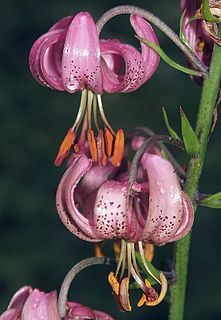Related Research Articles

Asparagales is an order of plants in modern classification systems such as the Angiosperm Phylogeny Group (APG) and the Angiosperm Phylogeny Web. The order takes its name from the type family Asparagaceae and is placed in the monocots amongst the lilioid monocots. The order has only recently been recognized in classification systems. It was first put forward by Huber in 1977 and later taken up in the Dahlgren system of 1985 and then the APG in 1998, 2003 and 2009. Before this, many of its families were assigned to the old order Liliales, a very large order containing almost all monocots with colorful tepals and lacking starch in their endosperm. DNA sequence analysis indicated that many of the taxa previously included in Liliales should actually be redistributed over three orders, Liliales, Asparagales, and Dioscoreales. The boundaries of the Asparagales and of its families have undergone a series of changes in recent years; future research may lead to further changes and ultimately greater stability. In the APG circumscription, Asparagales is the largest order of monocots with 14 families, 1,122 genera, and about 36,000 species.

The Dioscoreales are an order of monocotyledonous flowering plants in modern classification systems, such as the Angiosperm Phylogeny Group and the Angiosperm Phylogeny Web. Within the monocots Dioscoreales are grouped in the lilioid monocots where they are in a sister group relationship with the Pandanales. Of necessity the Dioscoreales contain the family Dioscoreaceae which includes the yam (Dioscorea) that is used as an important food source in many regions around the globe. Older systems tended to place all lilioid monocots with reticulate veined leaves in Dioscoreales. As currently circumscribed by phylogenetic analysis using combined morphology and molecular methods, Dioscreales contains many reticulate veined vines in Dioscoraceae, it also includes the myco-heterotrophic Burmanniaceae and the autotrophic Nartheciaceae. The order consists of three families, 22 genera and about 850 species.

Liliales is an order of monocotyledonous flowering plants in the Angiosperm Phylogeny Group and Angiosperm Phylogeny Web system, within the lilioid monocots. This order of necessity includes the family Liliaceae. The APG III system (2009) places this order in the monocot clade. In APG III, the family Luzuriagaceae is combined with the family Alstroemeriaceae and the family Petermanniaceae is recognized. Both the order Lililiales and the family Liliaceae have had a widely disputed history, with the circumscription varying greatly from one taxonomist to another. Previous members of this order, which at one stage included most monocots with conspicuous tepals and lacking starch in the endosperm are now distributed over three orders, Liliales, Dioscoreales and Asparagales, using predominantly molecular phylogenetics. The newly delimited Liliales is monophyletic, with ten families. Well known plants from the order include Lilium (lily), tulip, the North American wildflower Trillium, and greenbrier.

Galanthus is a small genus of approximately 20 species of bulbous perennial herbaceous plants in the family Amaryllidaceae. The plants have two linear leaves and a single small white drooping bell shaped flower with six petal-like (petaloid) tepals in two circles (whorls). The smaller inner petals have green markings.

The order Pinales in the division Pinophyta, class Pinopsida, comprises all the extant conifers. The distinguishing characteristic is the reproductive structure known as a cone produced by all Pinales. All of the extant conifers, such as cedar, celery-pine, cypress, fir, juniper, larch, pine, redwood, spruce, and yew, are included here. Some fossil conifers, however, belong to other distinct orders within the division Pinophyta.

The lily family, Liliaceae, consists of about 254 genera and about 4075 known species of flowering plants within the order Liliales. They are monocotyledonous, perennial, herbaceous, often bulbous geophytes. Plants in this family have evolved with a fair amount of morphological diversity despite genetic similarity. Common characteristics include large flowers with parts arranged in threes: with six colored or patterned petaloid tepals arranged in two whorls, six stamens and a superior ovary. The leaves are linear in shape, with their veins usually arranged parallel to the edges, single and arranged alternating on the stem, or in a rosette at the base. Most species are grown from bulbs, although some have rhizomes. First described in 1789, the lily family became a paraphyletic "catch-all" (wastebasket) group of petaloid monocots that did not fit into other families and included a great number of genera now included in other families and in some cases in other orders. Consequently, many sources and descriptions labelled "Liliaceae" deal with the broader sense of the family.

Thallophytes are a polyphyletic group of non-motile organisms traditionally described as "thalloid plants", "relatively simple plants" or "lower plants". They form an abandoned division of kingdom Plantae that include fungi, lichens and algae and occasionally bryophytes, bacteria and slime moulds. Thallophytes have a hidden reproductive system and hence they are also incorporated into the similarly abandoned Cryptogamae, as opposed to Phanerogamae. Thallophytes are defined by having undifferentiated bodies (thalli), as opposed to cormophytes (Cormophyta) with roots and stems. Various groups of thallophytes are major contributors to marine ecosystems.

Violales is a botanical name of an order of flowering plants and takes its name from the included family Violaceae and proposed by Lindley (1853). The name has been used in several systems, although some systems used the name Parietales for similar groupings. In the 1981 version of the influential Cronquist system, order Violales was placed in subclass Dilleniidae with a circumscription consisting of the families listed below. Some classifications such as that of Dahlgren placed the Violales in the superorder Violiflorae.

John Lindley FRS was an English botanist, gardener and orchidologist.

Stephan Ladislaus Endlicher also known as Endlicher István László was an Austrian botanist, numismatist and Sinologist. He was a director of the Botanical Garden of Vienna.
A system of plant taxonomy, the Takhtajan system of plant classification was published by Armen Takhtajan, in several versions from the 1950s onwards. It is usually compared to the Cronquist system. It admits paraphyletic groups.

A taxonomic system, the Bentham & Hooker system for seed plants, was published in Bentham and Hooker's Genera plantarum ad exemplaria imprimis in herbariis kewensibus servata definita in three volumes between 1862 and 1883.

Lilianae is a botanical name for a superorder of flowering plants. Such a superorder of necessity includes the type family Liliaceae. Terminations at the rank of superorder are not standardized by the International Code of Nomenclature for algae, fungi, and plants (ICN), although the suffix -anae has been proposed.

Lilioid monocots is an informal name used for a grade of five monocot orders in which the majority of species have flowers with relatively large, coloured tepals. This characteristic is similar to that found in lilies ("lily-like"). Petaloid monocots refers to the flowers having tepals which all resemble petals (petaloid). The taxonomic terms Lilianae or Liliiflorae have also been applied to this assemblage at various times. From the early nineteenth century many of the species in this group of plants were put into a very broadly defined family, Liliaceae sensu lato or s.l.. These classification systems are still found in many books and other sources. Within the monocots the Liliaceae s.l. were distinguished from the Glumaceae.

The Amaryllidaceae are a family of herbaceous, mainly perennial and bulbous flowering plants in the monocot order Asparagales. The family takes its name from the genus Amaryllis and is commonly known as the amaryllis family. The leaves are usually linear, and the flowers are usually bisexual and symmetrical, arranged in umbels on the stem. The petals and sepals are undifferentiated as tepals, which may be fused at the base into a floral tube. Some also display a corona. Allyl sulfide compounds produce the characteristic odour of the onion subfamily (Allioideae).

Amaryllidoideae is a subfamily of monocot flowering plants in the family Amaryllidaceae, order Asparagales. The most recent APG classification, APG III, takes a broad view of the Amaryllidaceae, which then has three subfamilies, one of which is Amaryllidoideae, and the others are Allioideae and Agapanthoideae. The subfamily consists of about seventy genera, with over eight hundred species, and a worldwide distribution.

The taxonomy of Liliaceae has had a complex history since the first description of this flowering plant family in the mid-eighteenth century. Originally, the Liliaceae or Lily family were defined as having a "calix" (perianth) of six equal-coloured parts, six stamens, a single style, and a superior, three-chambered (trilocular) ovary turning into a capsule fruit at maturity. The taxonomic circumscription of the family Liliaceae progressively expanded until it became the largest plant family and also extremely diverse, being somewhat arbitrarily defined as all species of plants with six tepals and a superior ovary. It eventually came to encompass about 300 genera and 4,500 species, and was thus a "catch-all" and hence paraphyletic taxon. Only since the more modern taxonomic systems developed by the Angiosperm Phylogeny Group (APG) and based on phylogenetic principles, has it been possible to identify the many separate taxonomic groupings within the original family and redistribute them, leaving a relatively small core as the modern family Liliaceae, with fifteen genera and 600 species.

Gilliesieae is a tribe of herbaceous geophyte plants belonging to the subfamily Allioideae of the Amaryllis family (Amaryllidaceae). Described in 1826, it contains fifteen genera and about eighty species. It has been variously treated as a subfamily or tribe. It is native to the Southern United States, Central and South America, predominantly Chile. Of the three tribes of genera that make up the subfamily Allioideae, Gilliesieae is the largest and most variable. The tribe was divided into two tribes in 2014, Gilliesiae s.s. and Leucocoryneae, based on differences in floral symmetry and septal nectaries.

Allioideae is a subfamily of monocot flowering plants in the family Amaryllidaceae, order Asparagales. It was formerly treated as a separate family, Alliaceae. The subfamily name is derived from the generic name of the type genus, Allium. It is composed of about 18 genera.

Coronariae is a term used historically to refer to a group of flowering plants, generally including the lilies (Liliaceae), and later replaced by the order Liliales. First used in the 17th century by John Ray, it referred to flowers used to insert in garlands. Coronariae soon came to be associated with Liliaceae in the Linnaean system. The term was abandoned at the end of the 19th century, being replaced with Liliiflorae and then Liliales.
References
- ↑ Lindley 1830.
- ↑ Lindley 1846, 1830 Lindley An Introduction &c.
- ↑ Lindley 1833.
- ↑ Lindley 1846, 1833 Lindley Nixus.
- ↑ Lindley 1836.
- ↑ Lindley 1846, 1836 Lindley A Natural System &c.
- ↑ Lindley 1838.
- ↑ Lindley 1846, 1838 Lindley Exogens.
- ↑ Lindley 1839.
- ↑ Lindley 1846, 1839 Lindley Botanical Register.
- ↑ Lindley 1846.
- ↑ Lindley 1847.
- 1 2 3 Lindley 1853.
- ↑ Lindley 1830, Summary tables p. xxxvii .
- 1 2 Lindley 1853, p. lv.
- ↑ Lindley 1830, General view .
- ↑ Lindley 1830, p. 345.
- ↑ Lindley 1853, p. 833.
- ↑ Lindley 1830, xlvi.
- ↑ Lindley 1830, Petaloideae p. 252.
- ↑ Lindley 1830, Petaloideae p. xlvi.
- ↑ Lindley 1830, Tripetaloideae.
- ↑ Lindley 1830, Hexapetaloideae.
- ↑ Lindley 1830, Spadiceae.
- ↑ Lindley 1853, Order XLVI: Amaryllidaceae - Amaryllids p. 155
- ↑ Lindley 1853, Order LXII: Liliaceae - Lilyworts p. 200
- ↑ Lindley 1846, p. lv.